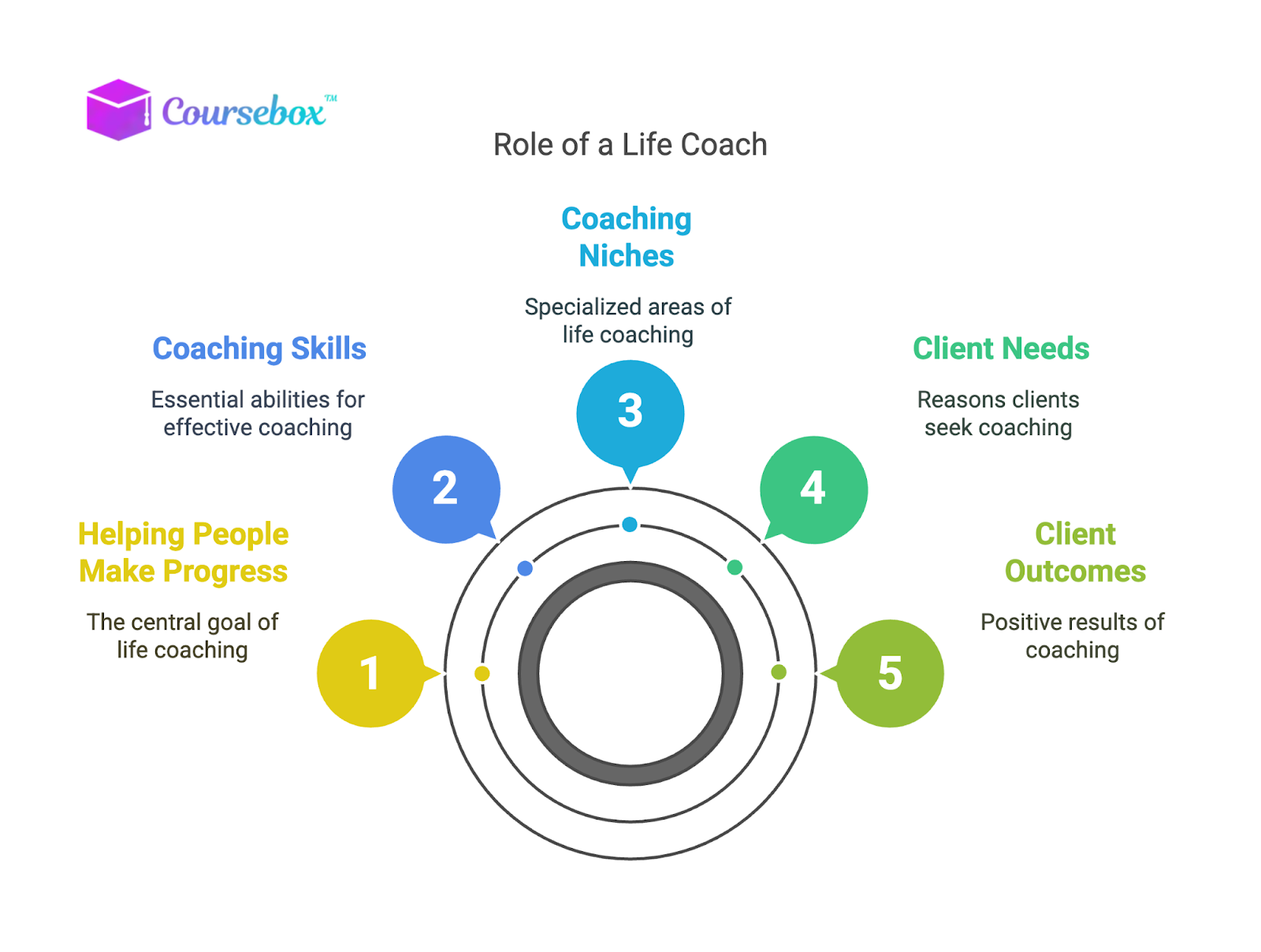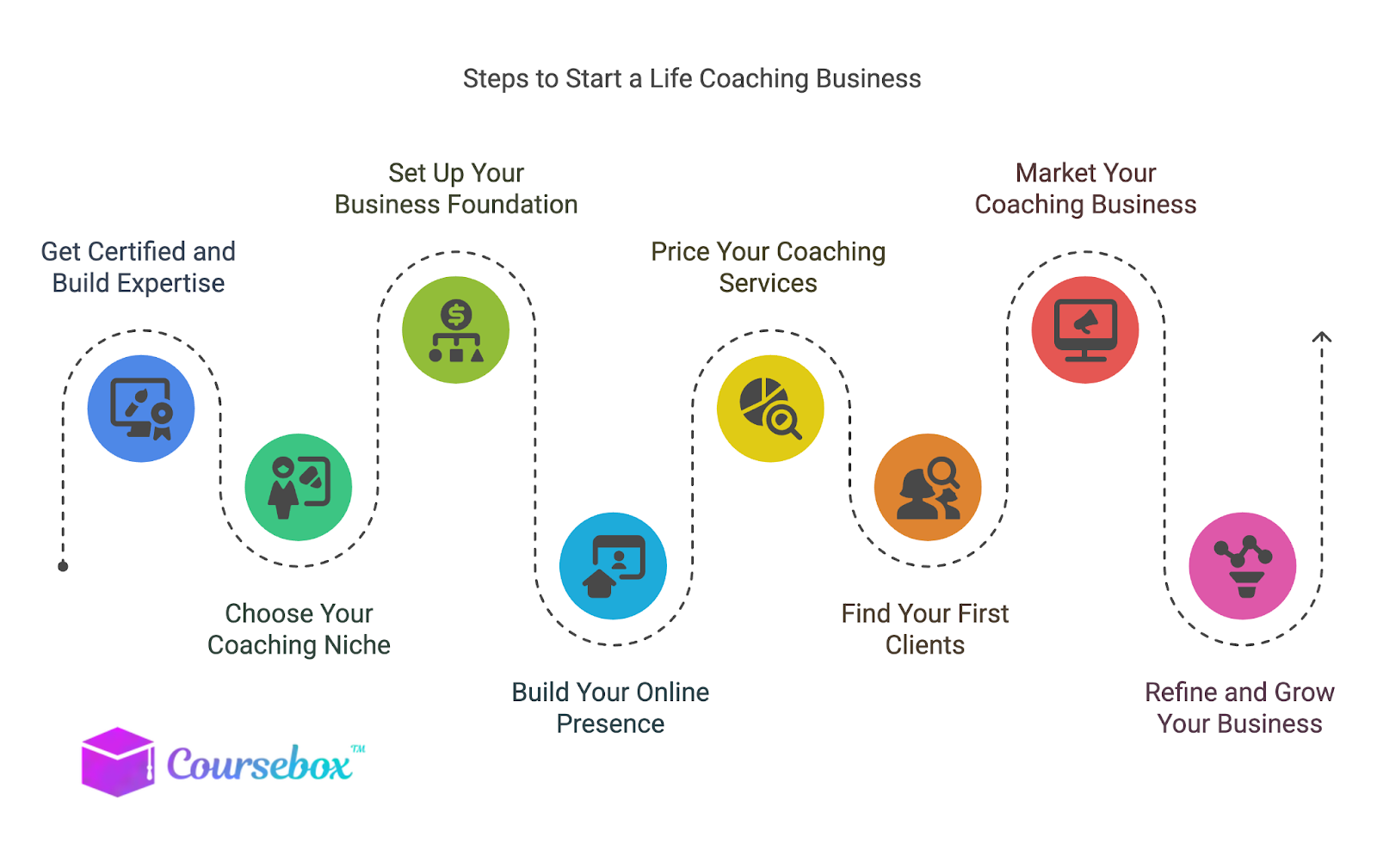How to Start a Life Coaching Business in 9 Achievable Steps (2025 Guide)
Want to launch your own life coaching business? Follow these 9 achievable steps to build, grow, and market your coaching practice.
Want to launch your own life coaching business? Follow these 9 achievable steps to build, grow, and market your coaching practice.
.webp)
Thinking about starting a life coaching business in 2025? You’re not alone. The coaching industry is projected to surpass $25 billion globally—and it’s growing fast!

Whether you're fresh out of certification or pivoting from another career, turning your passion for helping others into a thriving business is totally doable.
In this guide, I’ll walk you through clear, actionable steps so you don’t feel overwhelmed. Let’s turn that calling into a real business—step by step.

A life coach helps people set and reach personal or professional goals. They focus on the present and future—not the past. Unlike a therapist, a life coach doesn’t treat mental health issues.
And unlike a consultant, they don’t tell you what to do. Instead, they help you find your own answers through questions, reflection, and action steps.
There are many types of life coaches. Some focus on mindset and personal growth. Others work with executives, helping them lead better.
You’ll also find wellness coaches, relationship coaches, and career coaches. Each niche supports a different kind of client, but they all share a similar purpose: helping people make progress.
Great life coaches use specific skills like:
Clients often come to coaching because they feel stuck, want to change habits, or need help making decisions.
After working with a coach, they might feel more confident, motivated, and focused. They may also see real results, like better time management or stronger relationships. Coaching gives clients a safe, goal-oriented space to grow—step by step.

You don’t need a certification to legally call yourself a life coach in most places. Coaching isn’t regulated like therapy or medicine. But having a certification helps you build trust and learn solid skills. It also shows clients that you take your work seriously.
One of the most respected organizations is the International Coaching Federation (ICF). They offer approved programs and three levels of credentials. Another option is the National Board for Health & Wellness Coaching (NBHWC), especially if you want to focus on wellness.
Certification gives you a strong start—but it’s just the beginning. You grow most through real experience. That includes working with practice clients and finding a mentor who can give you feedback.
Keep learning by using:
Coaching is a skill that improves with time. Every session teaches you something new. And the more you learn, the more confident and helpful you become. Staying curious, open, and willing to improve will take you far in this work.
Your niche is the specific area you focus on as a coach. Picking a niche helps you speak clearly to the right people. It also makes your message stronger and more focused. When people see you specialize in their problem, they’re more likely to trust you.
Some profitable coaching niches include:
Start by looking at your own story. What have you gone through or overcome? What do people often ask you for help with? Your experiences and strengths can guide your choice. A good niche should feel natural to you.
Once you have a few ideas, make sure there’s real demand. You can:
If others are already coaching in that space, that’s a good sign. It means people are looking for support. You don’t have to coach everyone. Just the people who need your kind of help.
Once you’re ready to coach, it’s time to treat it like a real business. That starts with the basics—your name, setup, and systems.
Pick a business name that fits your style and niche. Then check that the name is available in your state and online. You’ll want to register it with your local government. From there, choose a business structure like a sole proprietorship, LLC (limited liability company), or another type. Each one affects how you pay taxes and protect your personal assets.
Next, open a business bank account. This helps you keep your coaching income and expenses separate. It also makes bookkeeping much easier come tax time.
Don’t forget the legal stuff:
Having these things in place builds trust and keeps you covered. You don’t need everything perfect right away. But starting with a solid foundation will save you stress later on. It also shows clients that you take your coaching—and their results—seriously.
Your online presence helps people find and trust you. It doesn’t have to be fancy—just clear and easy to use.
Start with a simple coaching website. It should have a homepage, an about page, a list of your services, and a contact page. You can build this yourself using platforms like Squarespace or Wix. Make sure it’s mobile-friendly and easy to read.
Use a professional email address that matches your domain (like hello@yourname.com). It looks more trustworthy than a personal Gmail. Also, set up a booking system so clients can schedule sessions without back-and-forth emails.
Your brand is more than a logo. It’s the way you look and sound online. Try to keep it consistent across all platforms:
Finally, link your social media profiles to your site. Whether you’re on Instagram, LinkedIn, or Facebook, make sure they reflect your brand and message. When people see a clear and consistent online presence, they’re more likely to reach out.
Figuring out what to charge can feel tricky at first. But pricing your coaching well helps you and your clients take the work seriously.
Start by choosing a pricing model. You can charge hourly, sell packages (like 6 sessions), or offer a full coaching program with added support and tools. Each has pros and cons. Programs work well if you have a clear process. Hourly is simpler but may limit growth.
It’s important to know your value. Don’t just guess based on what others charge. Think about your skills, your results, and the time you put in. Underpricing can lead to burnout.
When you’re just starting, it’s okay to offer introductory rates or take on beta clients. These are people who pay less in exchange for giving feedback or testimonials.
On your website, make sure your prices and what’s included are clear. This builds trust.
Here’s what to keep in mind:
Clear, fair pricing makes it easier for the right people to say yes.
When you’re just starting, getting your first few clients can feel like the hardest part. But you don’t need a big following—you just need a few ways to connect.
Start with your personal network. Tell friends, family, and coworkers what you’re doing. They might not need a coach, but they may know someone who does. A personal referral goes a long way.
You can also offer free or low-cost sessions in exchange for honest feedback or a short testimonial. These “practice clients” help you build confidence and social proof.
Online spaces are also helpful. Try posting in Facebook groups, writing on LinkedIn, or sharing tips on Instagram. Be helpful, not pushy. People notice when you show up with value.
And don’t forget to team up. Partnering with other coaches or small local businesses can expand your reach. You might host a workshop together or refer clients to each other.
Here are some simple ways to start:
Small steps like these can lead to real momentum.
Marketing helps people find you—and trust you. You don’t need to be everywhere, but showing up consistently matters.
Start by creating simple content. This could be a short blog, a few Instagram tips, or even a podcast. Share what you know and how you help. Over time, this builds authority. People start to see you as someone who understands their struggles.
Collect email addresses from your website or social media. Even if your list is small, you can send a monthly newsletter. Share coaching tips, stories, or upcoming sessions. Email lets you stay in touch without relying on social media.
Basic SEO (Search Engine Optimization) helps your content show up on Google. Use clear titles, helpful keywords, and write about topics your audience is searching for. Tools like Google Keyword Planner can help.
Once you understand your audience, try testing small paid ads. This could be on Facebook, Instagram, or Google. Start with a small budget to see what works.
Here’s how to begin:
Keep it simple and steady. That’s what builds trust over time.
Once you’ve worked with a few clients, it’s time to look at what’s working—and what’s not. Growth happens when you reflect and make small changes.
Start by asking for feedback after each coaching package or session. What helped them most? What was missing? Use this info to adjust your offers or improve your process.
Next, build simple systems that save time. Automate tasks like scheduling, payments, and follow-up emails.
Tools like Calendly or Dubsado can help. Or if you’re ready to turn your coaching into a more scalable offer, try an all-in-one platform like Coursebox.ai. It lets you host digital programs, track client progress, and even build certification paths—without juggling multiple tools.

As your confidence grows, think about offering more than 1:1 sessions. You might create a short online course or run a group program. These let you help more people at once and grow your income without adding more hours.
And don’t forget—you’re growing too. Keep learning through books, training, or peer support.
Here’s what to focus on:
Refining your business isn’t about big changes. It’s about small, steady improvements over time.
Starting a life coaching business doesn’t have to feel overwhelming. With these 9 achievable steps, you can move from idea to income—without skipping what matters most.
From certification to client attraction, each step builds the foundation for a long-lasting coaching practice.
Ready to start coaching with confidence? Take your first step today—and know that growth happens one client, one conversation, and one bold move at a time.
